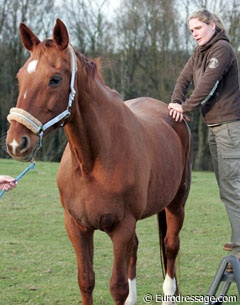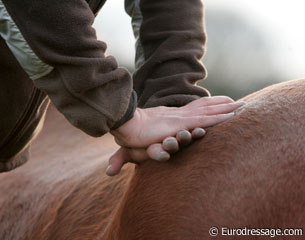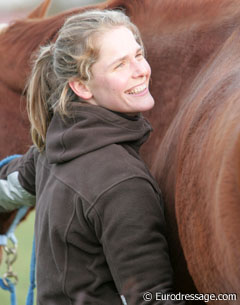
There is a general misconception that equine physiotherapy is only useful for top level competition horses. Active show horses that are trained hard and competed on a regular basis have to deal with a bigger workload and experience more stress on their muscles than recreation horses or retired campers that spent the day frolicking about in the field or hacking through the woods.
In 2007 I gave physiotherapy a first try: to see what it did to my own horse, which was at the time regularly ridden and trained at small tour level, though never competed. I called upon my friend Sarah Vermeerbergen, who lives in my home town and turns out to be an outstanding physio, quite famous in Europe and especially highly respected and called upon in the show jumping world. During her first session massaging my then 15-year old mare Grace, Sarah worked on suppling her neck as well as her intercostal muscles. The next day I rode her I felt remarkable difference in my horse. While warming up Grace was having fun and shaking her head and neck regularly as if it she felt loose for the first time in years. I was impressed, but unfortunately due to circumstances I couldn't carry on the sessions.
Fast forward to December 2009. Much has changed since then. My soon to be 18-year old Grace is now retired in the field and the only work she still has to do is controlling my rambunctious 22-year old New Forest Pony, preventing her from terrorising other herd members. Time for Sarah to do a check-up on my horse, which has now lost all her muscles due to no training. Her back has slightly caved in and she no longer looks filled and buff.
Sarah started with a general check up, looking for tension and hot spots in her muscles going from neck to shoulder, back, hindquarters and legs. Grace has a history of being very stiff in the neck and back so Sarah initially worked on her neck by stretching her muscles and loosening her vertebrae one by one. You could clearly hear that the vertebra crepitated when they 'unlocked'. It was a sign of arthritis often heard in the joints of older horses. As soon as my mare released her musculature, Sarah was able to manipulate the joints to get better movement in them.
Grace is a very hormonal mare and is suffering from outrageous heat cycles (11 days in heat per month). I had an appointment with the vet scheduled to have an ultrasound done the same day but hadn't told Sarah about it. This put Sarah to the test, of course, and she passed summa cum laude! Sarah immediately noticed a tremendous amount of tension in Grace's back and especially on her iliocostal muscle en longissimus (loin +croup section). Her muscles were completely blocked there and she even kicked out to Sarah's touch, something my horse would never do. "Imagine a woman having her period and suffering from back pain. That's her," Sarah told me. She noticed that the left side near her left teat was a bit warm which could also indicate a hormonal imbalance.
Sarah switched between soft tissue manipulation (waiting for the muscles to reflex to her touch and relax) and muscle mobilisation, which my horse enjoyed much more. The muscles seemed to roll over her hands while she was moving the horse's hamstring muscles.
At a certain point Sarah put her fingers in Grace's pectorals to make her back go up and create movement in the spinal cord. My mare hardly responded to her touch which indicated severe stiffness. By the end of the session, she did lift her back to a certain extent but it certainly did not show the level of flexibility hoped for.
Most of the time, Sarah's hands create friction from the superficial to the depth of the muscle tissue and on the sore spots she applies pressure. Grooming with the currycomb is highly recommended as it stimulates the muscles and promotes blood flow. Her techniques encompass physiotherapy, chiropractics (thrusts with her hand) and osteopathy.
Sarah finished Grace's session by standing on a stool and putting her two hands together to push up and down the ribcage and afterwards the hip bone. A loose, relaxed horse would nod his head like a rocking horse; mine stood still like a statue with only the tip of her ears flopping slightly. Conclusion: Grace is definitely a work in progress.
 Later that day the vet scanned her ovaries and even though she was not in heat she had at least 14 follicles in each ovary. Her heat cycle now needs to be controlled with Regumate (for a period of time). Sarah advised me to wait two weeks for a next physio session with Grace in order for the hormones to kick in and take away some of the muscle strain in her back.
Later that day the vet scanned her ovaries and even though she was not in heat she had at least 14 follicles in each ovary. Her heat cycle now needs to be controlled with Regumate (for a period of time). Sarah advised me to wait two weeks for a next physio session with Grace in order for the hormones to kick in and take away some of the muscle strain in her back.
Sarah moved on to a second horse in the stable: the 10-year old American Quarter Horse gelding Wimpy's Country Bud, who has not been trained or ridden for the last half year. His owner Christel has done Natural Horsemanship ground exercises with him but hasn't ridden him anymore because she lost her confidence after falling off hard when he spooked and took off while hacking.
Sarah started her session with "Wim" taking a look at his walk on the straight line on hard surface. She immediately noticed an imbalance in mobility in the pelvis. Wim's right hind leg showed less stretch and scope which he compensated with his stifle, while the left hind leg was swinging and stepping under. As Sarah was asking Christel to describe the horse's behaviour under saddle and in hand, it become more and more obvious that Christel's issues managing this Quarter Horse could be pinned down to this pelvic problem. Under saddle Wim was rushing away and trying to lean on the bit. On the left track he leaned against Christel's left leg and always preferred the left canter to the right.
"So often owners blame the horse's behaviour for their problems by saying, 'he's just obnoxious or annoying like that,' but very often there is an underlying issue why a horse is doing it," Sarah explained. More evidence came to the fore as Christel acknowledged that picking his right hind hoof has always been hard with him kicking out or not trying to left and hold the hoof up.
In Wim's case Sarah recommended training exercises such as leg yield and shoulder in so that the right hind leg steps under more. She also said that tempo changes are good as long as there is plenty of variation in the exercises and they are not carried out for too long.
Even though Wim has not been trained he has considerably more muscle build-up in his hindquarters than my horse Grace, but this is genetically determined with American Quarter Horses. They have short and thick muscles which are explosive compared to warmblood horses.
Sarah also tested Wim's spinal cord flexibility by putting her fingers in his pectorals. Wim curled like a cat; what a difference with Grace!! Sarah finished her session by watching Wim move again in walk on the hard surface. Though the problem was not fixed in one hour, you could clearly see an improved mobility in the right leg and more swing in the pelvis.
I was very impressed by Sarah's professionalism, insight and knowledge of biomechanics. In the next few months, she will be stopping by Eurodressage headquarters to do more massage sessions, on which we will take notes and write articles.
 Sarah Vermeerbergen is a certified physiotherapist who got her Master's Degree in equine and canine physiotherapy at the University of Ghent in Belgium. She is a specialist in myofascial triggerpoint therapy and did an internship in equine clinic Sudenhof in Osnabruck, Germany, to further her knowledge in post-operative treatment of horses. She also did the masterclass ''Physiotherapie fur Pferde" conducted by the German Federation of Physiotherapists. She traveled to the South of Germany to work with renowned equine physiotherapist Christel Auer for two years. Auer works for the Bulgarian Show jumping team and has assisted Olympic champion Rodrigo Pessoa at the Olympics and World Equestrian Games. Sarah Vermeerbergen has worked for international show jumpers Ludo Philippaerts, Lars Nieberg, Dirk Demeersman and Jean-Claude van Geenberghe. She also massaged riders such as Jos Lansink. She was the official equine physiotherapist for the Ukrainian show jumping team that made history by finishing fourth at the 2006 World Equestrian Games. Currently she works in Belgium and The Netherlands for numerous international dressage and show jumping riders.
Sarah Vermeerbergen is a certified physiotherapist who got her Master's Degree in equine and canine physiotherapy at the University of Ghent in Belgium. She is a specialist in myofascial triggerpoint therapy and did an internship in equine clinic Sudenhof in Osnabruck, Germany, to further her knowledge in post-operative treatment of horses. She also did the masterclass ''Physiotherapie fur Pferde" conducted by the German Federation of Physiotherapists. She traveled to the South of Germany to work with renowned equine physiotherapist Christel Auer for two years. Auer works for the Bulgarian Show jumping team and has assisted Olympic champion Rodrigo Pessoa at the Olympics and World Equestrian Games. Sarah Vermeerbergen has worked for international show jumpers Ludo Philippaerts, Lars Nieberg, Dirk Demeersman and Jean-Claude van Geenberghe. She also massaged riders such as Jos Lansink. She was the official equine physiotherapist for the Ukrainian show jumping team that made history by finishing fourth at the 2006 World Equestrian Games. Currently she works in Belgium and The Netherlands for numerous international dressage and show jumping riders.
Sarah Vermeerbergen's official website is www.paardenkine.be.
For questions about equine physiotherapy or to book her for a session, please contact her at info@paardenkine.be